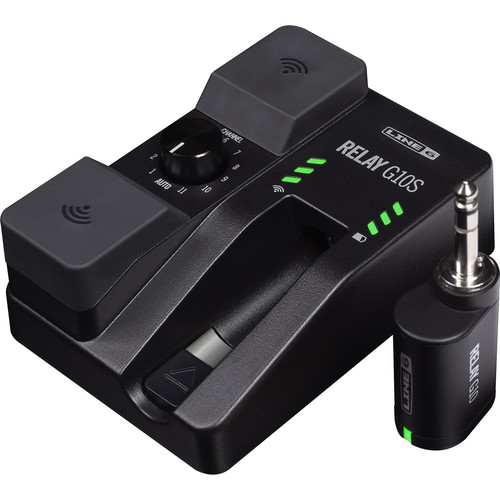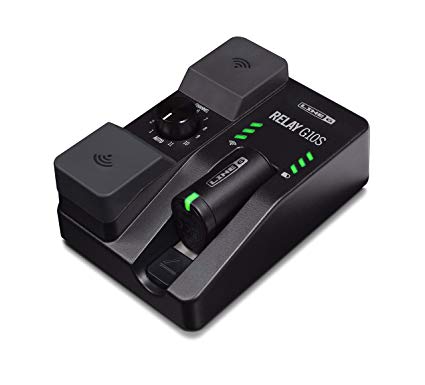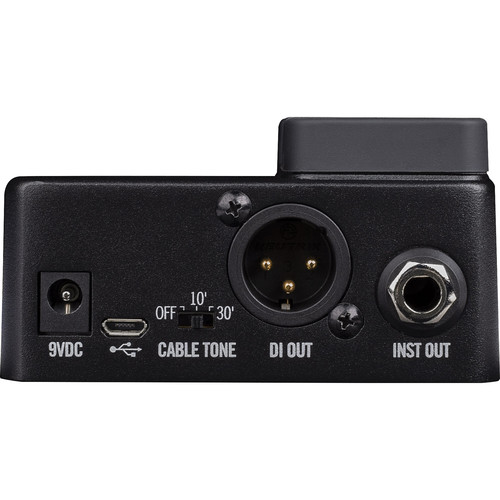 Wireless technology has come a long way over the past couple decades, and analog and digital units both are upping their game with improvements in sound quality, performance, and reduced latency. The Line6 G10S is the newest member of the Line6 Relay wireless family, which offers a broad range of wireless units for all applications and budgets.
Wireless technology has come a long way over the past couple decades, and analog and digital units both are upping their game with improvements in sound quality, performance, and reduced latency. The Line6 G10S is the newest member of the Line6 Relay wireless family, which offers a broad range of wireless units for all applications and budgets.
The G10S is designed as a digital entry-level device for stage or pro-performance use. The receiver is housed in a small stombox-sized enclosure – which is metal for durability – and made to integrate onto a pedalboard setup. The transmitter is a small self-contained unit that requires no cables or body packs. It’s the size of a car key fob and simply plugs into your instrument and you’re set to go. The receiver housing also serves as the charging base for the transmitter. Two sets of LEDs for frequency strength and battery charging are illuminated on the top of the receiver and are easy to read.
 The G10S has more than double an increase in range over the G10 model (The G10 is positioned as entry-level for basic and home use, not pro stage use) by using a dual diversity antenna system, which enables the G10S to have a range of up to 130’. The G10S also allows for both automatic frequency selection, which will change depending on the venue you use it at to improve the signal strength, or you can choose manual channels if running more than one G10S system.
The G10S has more than double an increase in range over the G10 model (The G10 is positioned as entry-level for basic and home use, not pro stage use) by using a dual diversity antenna system, which enables the G10S to have a range of up to 130’. The G10S also allows for both automatic frequency selection, which will change depending on the venue you use it at to improve the signal strength, or you can choose manual channels if running more than one G10S system.
Another interesting feature is the cable tone switch on the back of the unit which mimics the reduced high frequency roll off one would have while using a cable. It’s subtle, but if your tone is naturally a little bright and you want more of the “cable sound,” the G10S has you covered with two different settings between 10′ and 30′.
 The G10S is designed to work with any instrument that uses a 1/4-inch output, but it’s also equipped with its own two outputs for ¼-inch and XLR respectively so you could go directly into the mixing board as well. A micro-USB is also on the receiver which can be used for firmware updates. The G10S is powered by a 9v DC connector and comes with its own power supply.
The G10S is designed to work with any instrument that uses a 1/4-inch output, but it’s also equipped with its own two outputs for ¼-inch and XLR respectively so you could go directly into the mixing board as well. A micro-USB is also on the receiver which can be used for firmware updates. The G10S is powered by a 9v DC connector and comes with its own power supply.
Performance: The Test
The Line6 Relay G10S is certainly easy to use and has quite a solid feature set and a nice design. But none of that matters if the G10S won’t perform. So how did it do?
We took the G10S through its paces playing events and club shows throughout the Bay Area with my band Electric X for two months. The first thing that was noted as a clear benefit for wireless use was for sound check. Often a performing musician’s mix onstage will be quite different than what comes out of the speakers and into the audience. Going wireless and being able to move about the room before a show was invaluable for us and we often made tweaks in the mains mix just based on our ability to move about freely.
When it was time to perform, the G10S performed without a glitch or any hiccups. Over the course of two months, we played at nearly a dozen different venues throughout the Bay Area and the G10S performed great everytime. The tone was excellent, there was no latency detected, and we were able to easily push into the 100’+ range tested offstage before there was any hint of a drop out occurring.
One area to critique though, and because it is a digital pedal is it does consume a lot of power. The power adapter Line6 supplies the G10S with wants 500mA of power, so this means if you want to add the G10S to your pedal board’s own power supply system rather than use the power adapter that Line6 includes, you’ll want to ensure that you get a power supply that has an output that can give the necessary juice for the G10S. Fortunately, with the popularity of other high-consumption digital devices like Strymon pedals, most modern power supply units for pedalboards will offer high-current outputs. In some cases, vendors offer special cables which will allow you to combine two lower-current outputs together to create one of high-current. We used a Cioks Adam power supply on a PedalTrain Metro board and a current-doubling cable, and then the G10S was able to run on a single power supply along with the other pedals on the board. Problem solved.
At $249.99, the Line6 G10S costs about what a typical boutique effects pedal would run, and in many ways, the wireless experience was a lot more fun! We were pleased to see that Line6’s Relay G10S could indeed perform so well at such a great price and overall value. Kudos are definitely in order to the Line6 team for the fantastic Relay G10S.